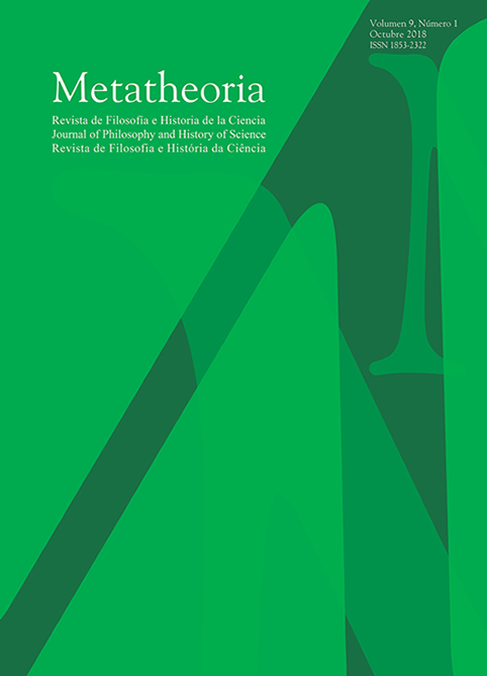El interferómetro de Michelson: entre el éter y las ondas gravitacionales
DOI:
https://doi.org/10.48160/18532330me9.214Palavras-chave:
interferómetro, éter, ondas gravitacionales, FeyerabendResumo
En este trabajo se presenta una reconstrucción de dos de los usos experimentales más sobresalientes del interferómetro de Michelson en la historia de la ciencia: la medición del éter (1881,1887) y la detección de las ondas gravitaciones (2015). A partir de las diferentes interpretaciones de estos dos momentos estelares en la física, relativos a un mismo dispositivo experimental, me propongo recuperar algunas afirmaciones del filósofo Paul Feyerabend respecto a la relación entre teoría y experiencia, las cuales se ilustran plausiblemente con estos ejemplos. Al mismo tiempo, incorporo elementos sociológicos y psicológicos explorados por Harry Collins en sus estudios sobre ondas gravitaciones que pueden ser integrados plausiblemente en tal perspectiva, si bien esto tipo de elementos no suelen ser utilizados por el filósofo austriaco.
Referências
Abbott, B. P. et al. (2016), “Observation of Gravitational Waves from a Binary Black Hole Merger”, Physical Review Letters116: 061102.
Bridgman, P. W. (1936), The Nature of Physical Theory, Princeton: Princeton University Press.
Collins, H. (2004), Gravity’s Shadow. The Search for Gravitational Waves, Chicago: University of Chicago Press.
Collins, H. (2014), Gravity’s Ghost and Big Dog. Scientific Discovery and Social Analysis in the Twenty-First Century,Chicago: University of Chicago Press.
Eddington, A. (1939), The Philosophy of Physical Science, New York: The Macmillan Company.
Einstein, A. (1923), “On the Electrodynamic of Moving Bodies”, en Einstein, A., Lorentz, H. A., Weyl, H. y H. Minkowski, The Principle of Relativity, New York: Dover, pp. 35-65.
Einstein A. y N. Rosen (1937), “On Gravitational Waves”, Journal of the Franklin Institute223(1): 43-54.
Eisenstaedt, J. (2015), Antes de Einstein: relatividad, luz y gravitación, México: Fondo de Cultura Económica.
Feyerabend, P.K. (1975), Tratado contra el método. Esquema de una teoría anarquista del conocimiento, Madrid: Tecnos.
Feyerabend, P.K. (1981a), “An Attempt at a Realistic Interpretation of Experience”, en Feyerabend, P. K., Realism, Rationalism, and Scientific Method. Philosophical Papers Vol. 1, Cambridge: Cambridge University Press, pp. 17-36.
Feyerabend, P.K. (1981b), “On The Interpretation of Scientific Theories”, en Feyerabend, P. K., Realism, Rationalism, and Scientific Method. Philosophical Papers Vol. 1,Cambridge: Cambridge University Press, pp. 37-43.
Feyerabend, P.K. (1981c), “Explanation, Reduction and Empiricism”, en Feyerabend, P. K., Realism, Rationalism, and Scientific Method. Philosophical Papers Vol. 1, Cambridge: Cambridge University Press, pp. 44-96.
Feyerabend, P.K. (1981d), “Science Without Experience”, en Feyerabend, P. K., Realism, Rationalism, and Scientific Method. Philosophical Papers Vol. 1,Cambridge: Cambridge University Press, pp.132-136.
Feyerabend, P.K. (1999a), “How to Be a Good Empiricist: A Plea for Tolerance in Matters Epistemological”, en Feyerabend, P. K.,Knowledge, Science and Relativism. Philosophical Papers Vol. 3, Cambridge: Cambridge University Press, pp. 78-103.
Feyerabend, P.K. (1999b), “The Problem of the Existence of Theoretical Entities”, en Feyerabend, P. K., Knowledge, Science and Relativism. Philosophical Papers Vol. 3,Cambridge: Cambridge University Press, pp. 16-49.
Feyerabend, P. K. (2003), Provocaciones filosóficas, Madrid: Biblioteca Nueva.
Holton, G. (1969), “Einstein, Michelson and the ‘Crucial’ Experiment”, Isis 60: 133-169.
Janssen, M. (2002), “Reconsidering a Scientific Revolution: The Case of Einstein versus Lorentz”, Physics in Perspective4: 421-446.
Kompaneyets, A.S. (1962), Theoretical Physics, New York: Dover.
Kostro, L. (2000), Einstein and the Ether, Montreal: Apeiron.
Michelson, A.A. (1881), “The Relative Motion of the Earth and of the Luminiferous Ether”, American Journal of Science, Series 3, 22: 120-129.
Miller, A.I. (1984), Albert Einstein’s Special Theory of Relativity. Emergence (1905) and Early Interpretation(1911), New York: Springer.
Ramírez, S. (2006), “Feyerabend: la tradición empirista y la carga teórica de la observación”, en López, C. (ed.), Perspectivas y horizontes de la filosofía de la ciencia a la vuelta del tercer milenio, México: UNAM, pp. 19-39.
Reichenbach, H. (1958), The Philosophy of Space and Time, New York: Dover.
Staley, R. (2008), Einstein’s Generation. The Origins of the Relativity Generation, Chicago: University of Chicago Press.
Swenson, L.S. (1970), “The Michelson-Morley-Miller Experiments before and after 1905”, Journal for the History of Astronomy 1: 56-78.
Swenson, L.S (1972), The Ethereal Aether. A History of Michelson-Morley-Miller Aether-Drift Experiments, 1880-1930, Austin: University of Texas Press.
Taylor, J.H. y J.M. Weisberg (1982), “A New Test of General Relativity: Gravitational Radiation and the Binary Pulsar PSR 1913+16”, Astrophysical Journal1(253): 908-920.
Zahar, E. (1973a), “Why Einstein’s Programme Supersede Lorentz’s? (I)”, British Journal of Philosophy of Science24(2): 95-123.
Zahar, E. (1973b), “Why Einstein’s Programme Supersede Lorentz’s? (II)”, British Journal of Philosophy of Science24(3): 223-262.
Downloads
Publicado
Como Citar
Edição
Seção
Licença
Copyright (c) 2020 Metatheoria – Revista de Filosofia e História da CiênciaOs documentos publicados aqui são regidos pelos critérios de licenciamento Creative Commons Argentina.Atribución - No Comercial - Sin Obra Derivada 2.5





